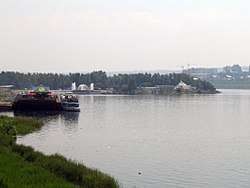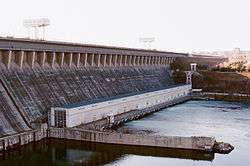Angara
The Angara (Buryat and Mongolian: Ангар, Angar, lit. "Cleft"; Russian: Ангара́, Angará) is a major river in Siberia, which traces a course through Russia's Irkutsk Oblast and Krasnoyarsk Krai. It drains out of Lake Baikal and is the headwater tributary of the Yenisey.[1] It is 1,849 kilometres (1,149 mi) long, and has a drainage basin of 1,039,000 square kilometres (401,000 sq mi).[2] It was formerly known as the Lower or Nizhnyaya Angara (distinguishing it from the Upper Angara).[3] Below its junction with the Ilim, it was formerly known as the Upper Tunguska (Russian: Верхняя Тунгуска, Verkhnyaya Tunguska, distinguishing it from the Lower Tunguska)[4][5] and, with the names reversed, as the Lower Tunguska.[6]
| Angara | |
|---|---|
 The Angara at Irkutsk | |
 | |
| Physical characteristics | |
| Source | Lake Baikal |
| ⁃ coordinates | 51.867°N 104.818°E |
| Mouth | Yenisey |
⁃ coordinates | 58.102°N 92.991°E |
| Length | 1,849 km (1,149 mi) |
| Discharge | |
| ⁃ average | 4,530 m3/s (160,000 cu ft/s) |
| Basin features | |
| Progression | Yenisey→ Kara Sea |
Leaving Lake Baikal near the settlement of Listvyanka, the Angara flows north past the Irkutsk Oblast cities of Irkutsk, Angarsk, Bratsk, and Ust-Ilimsk. It then turns west, enters the Krasnoyarsk Krai, and joins the Yenisey near Strelka, 40 kilometres (25 mi) south-east of Lesosibirsk.
Dams and reservoirs

Four dams of major hydroelectric plants - constructed since the 1950s - exploit the waters of the Angara:
- Irkutsk Dam, forming the Irkutsk Reservoir, which floods the valley of the river from its source to Irkutsk, and slightly raises the water level in Lake Baikal
- Bratsk Dam, forming the Bratsk Reservoir
- Ust-Ilimsk Dam, at Ust-Ilimsk, forming the Ust-Ilimsk Reservoir
- Boguchany Dam, at Kodinsk
The reservoirs of these dams flooded a number of villages along the Angara and its tributaries (including the historic fort of Ilimsk on the Ilim), as well as numerous agricultural areas in the river valley. Due to its effects on the way of life of the rural residents of the Angara valley, dam construction was criticized by a number of Soviet intellectuals, in particular by the Irkutsk writer Valentin Rasputin - both in his novel Farewell to Matyora (1976) and in his non-fiction book Siberia, Siberia (1991).
Navigation
The Angara is navigable by modern watercraft on several isolated sections:[7][8][9]
- from Lake Baikal to Irkutsk
- from Irkutsk to Bratsk
- on the Ust-Ilimsk Reservoir
- from the Boguchany Dam (Kodinsk) to the river's fall into the Yenisey.
The section between the Ust-Ilimsk Dam and the Boguchany Dam has not been navigable due to rapids. However, with the completion of the Boguchany Dam, and filling of its reservoir, at least part of this section of the river will become navigable as well. Nonetheless, this will not enable through navigation from Lake Baikal to the Yenisey, as none of the existing three dams has been provided with a ship lock or a boat lift, nor will the Boguchany Dam have one.

Despite the absence of a continuous navigable waterway, the Angara and its tributary the Ilim were of considerable importance for Russian colonization of Siberia since ca. 1630, when they (and the necessary portages) formed important water routes connecting the Yenisey with Lake Baikal and the Lena. The river lost its transportation significance after the construction of an overland route between Krasnoyarsk and Irkutsk and, later, the Trans-Siberian Railway.
See also
References
Citations
- "Angara River". Encyclopædia Britannica Online. Retrieved 2006-10-26.
- Река АНГАРА in the State Water Register of Russia (Russian)
- EB (1878).
- ВЕРХНЯЯ ТУНГУСКА (Verkhnyaya Tunguska, in the dictionary of Russia's place names).
- Tunguska, in Columbia Electronic Encyclopedia
- See, e.g., the 1773 Kitchen map above.
- Angara River, southeast-central Russia
- Енисейское пароходство: Ангара – судоходство и грузоперевозки (Yenisey Shipping Company: Angara — navigation and cargo shipping) (in Russian)
- Особенности движения и стоянки судов по внутренним водным путям Восточно-Сибирского бассейна Archived March 13, 2008, at the Wayback Machine (Special navigation rules for the internal waterways of the Eastern Siberia Basin) (in Russian)
- Ангара, Great Soviet Encyclopedia
Bibliography
- , Encyclopædia Britannica, 9th ed., Vol. II, New York: Charles Scribner's Sons, 1878, p. 26.
External links
| Wikimedia Commons has media related to Angara River. |